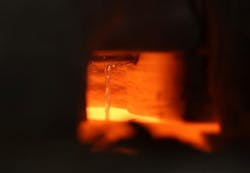A ceramic-based mechanical pump developed at the Georgia Institute of Technology, with help from engineers at Purdue and Stanford, can move high-temperature (1,400°C) liquids such as molten tin. This could lead to high-efficiency, low-cost thermal storage for holding renewable energy generated by wind and solar power. Another potential use is extracting hydrogen directly from fuels such as methane without creating carbon dioxide. Ceramic components are normally too brittle for mechanical devices, but researchers relied on precision machining and seals made from graphite—another high-temperature material.
Until now, engineers had a limit on the highest temperatures at which they could move and store liquids. And the hotter a storage device can operate, the more efficiently it stores and uses thermal energy.
Thermal energy, fundamental to power generation and a host of industrial processes, is most valuable at high temperatures because entropy, which makes thermal energy unavailable for conversion, declines at higher temperatures. Liquid metals such as molten tin and silicon could be useful in thermal storage and transfer, but until now, engineers didn’t have pumps and pipes that could withstand such extreme temperatures.
Ceramic materials can withstand the heat, but they are brittle, and many researchers felt they couldn’t be used in mechanical applications such as pumps. Still, the researchers decided to give it a try. They started with an external gear pump, which uses rotating gear teeth to suck in the liquid tin and push it out of an outlet. That technology differs from centrifugal and other pump technologies, but it was chosen for its simplicity and ability to operate at relatively low speeds. The gears were custom-manufactured by a commercial supplier and modified.
Addressing another challenge, the researchers made seals of graphite for the pump, piping, and joints. Seals are normally made from flexible polymers, but they cannot withstand high temperatures. Graphite’s flexibility and strength made it well-suited to the application. The pump operates in a nitrogen environment to prevent oxidation at the extreme temperatures.
The pump operated for continuously for 72 hours at a few hundred revolutions per minute at an average temperature of 1,473 Kelvin—with brief operation up to 1,773 Kelvin in other experimental runs. Because the researchers used a relatively soft ceramic known as Shapal, a form of aluminum nitride known for its ease of machining, the pump sustained wear. But other ceramics with greater hardness will overcome that issue, and the team is already working on a new pump made with silicon carbide (SiC).
Among the most interesting applications for the high-temperature pump would be low-cost grid storage for surplus energy generated by renewables. Electricity created by solar or wind sources could heat molten silicon, creating thermal storage that could be used when needed to generate electricity.
Storing energy in the form of heat could be cheaper than any other form of energy storage, say researchers. They are also looking at using the molten-metal pump as part of a device to extract hydrogen from methane without generating carbon dioxide. Because liquid tin doesn’t react with hydrocarbons, bubbling methane into liquid tin would crack the molecule to produce hydrogen and solid carbon—without generating carbon dioxide, a greenhouse gas.
The pump could also let higher temperature materials and processes be used in place of molten salts in concentrated solar power applications. The combination of liquid tin and ceramics could operate at higher temperatures without corrosion, enabling higher efficiency and lower costs.
The ceramic pump uses gears measuring 36 mm in diameter, but scaling it up for industrial processing wouldn’t require dramatically larger components. For example, by increasing pump dimensions by a factor of only four or five and operating the pump near its maximum rated speed, the total heat that could be transferred would increase by a factor of a thousand (from 10 kW to 100 MW). This would be consistent with utility-sized power plants.
Molten silicon, with still-higher temperatures, may be more useful for storage because of its lower cost. The pump could operate at much higher temperatures than those demonstrated so far, even past 2,000°C.


